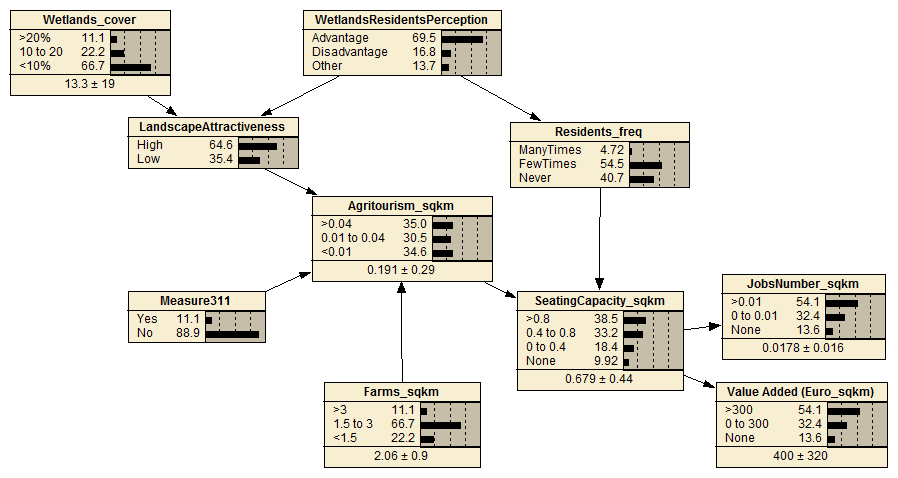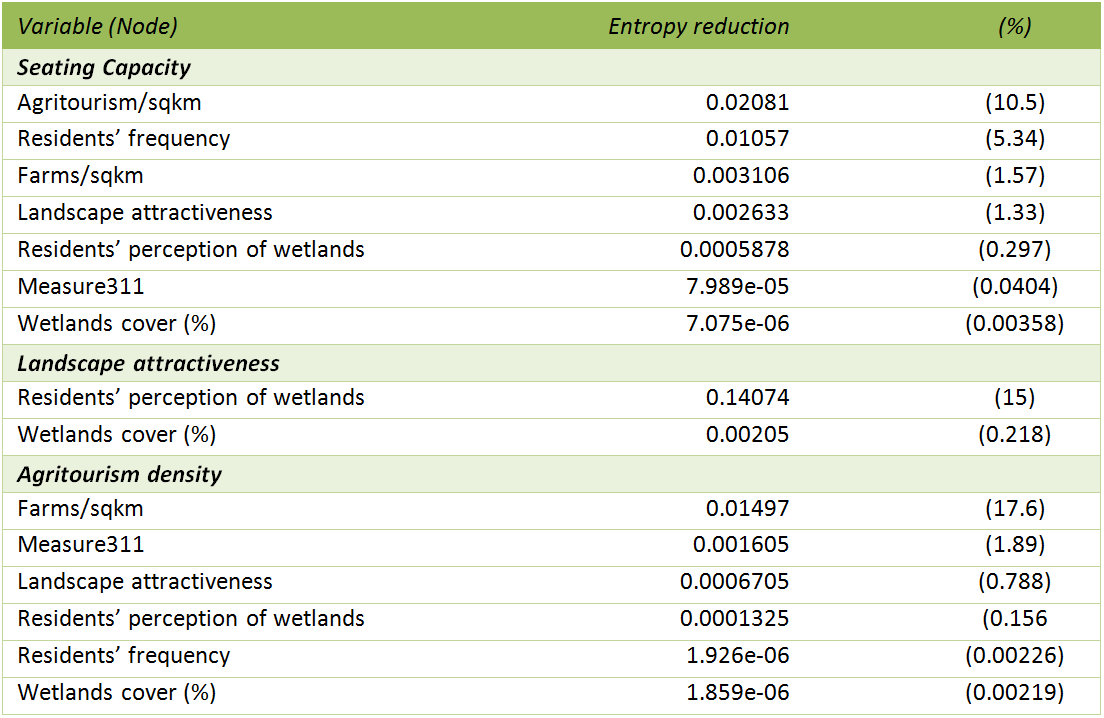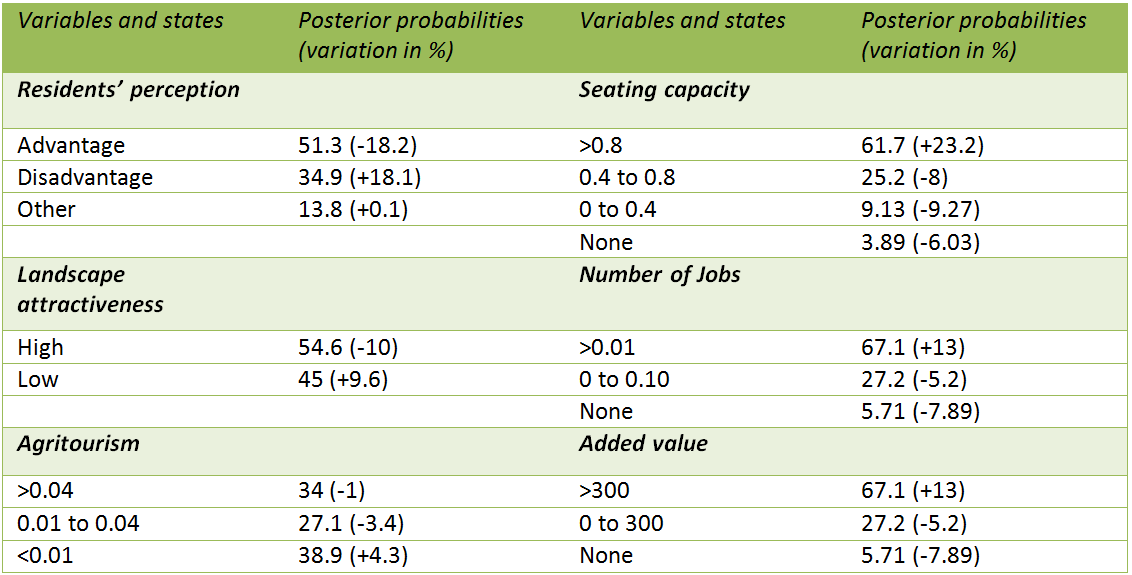Objective
The main objective of this ad-hoc study was to estimate the likely contribution of wetlands and semi- natural vegetation to the local economy of the Third Agrarian Region (893 Km2) located in the eastern plains of the province of Ferrara.
Methodology
To simulate the downstream effects of the use of public goods in the local economy, we used Bayesian Belief Networks (BBNs). The model is based on evidence about perceptions of the local landscape and the frequency with which residents consume meals in the agritourism’s restaurants. We mixed data from different sources: a survey in the study area conducted in July 2013 (N=285 residents) (see Galimberti, Raggi & Viaggi, 2014), regional statistics to obtain empirical data on population, farms, agritourism activities and in general with regard to land use. All data was managed at the municipality level. A literature review and local expert judgments were necessary to make up for missing data and to establish a preliminary conceptual model.
Our conceptual model is based on the idea that consumers (represented by local residents) may use public goods not only directly (free) but possibly also through a second-order services (second-order effect), developed by an intermediate agent (i.e. the agritourism farm). We assumed that agritourism activities are influenced by the specific quality of the public good (e.g. landscape attractiveness) based on either the presence of landscape elements of high interest (e.g. wetlands) and the perception that local residents have of them. We used food service (measured by seating capacity) as an example of second-order effects.
Results
Our results showed that landscape attractiveness (public good) is highly influenced by residents’ positive perception of wetlands and little by the actual wetland cover. Landscape attractiveness influences seating capacity (second-order effect) without a direct link to it (Figure 1) but through the agritourism farm. The sensitivity analysis of the network (see Table 1) showed that the most significant factor influencing the agritourism seating capacity (i.e. second-order effect) was the agritourism density, followed by the frequency with which residents choose to eat at the agritourism structure.
On the other hand, agritourism density is linked to the density of farms and financial support policies (e.g. Measure 311: farm diversification). However, the sensitivity analysis showed that measure 311 has little impact on agritourism density since only few farms in only one municipality of the study area have applied for support from this measure.
The predicted seating capacity of the agritourism farms contributes to increase both the number of jobs and the value added of farms (Figure 1). Simulating changes in key variables, for example increasing the frequency of consuming meals (i.e. Residents_freq=Many times), result in a likely increase of the seating capacity (+23.2%), which can in turn trigger an increase in the number of jobs and the added value of farms (+13% each) (see Table 2). Similarly, an augmentation in the participation in measure 311 (Measure311=Yes) will likely increase the moderate density of agritourism farms (+47.3%), but this does not have a noteworthy influence on the other variables in the network, as can be seen in the small change in the posterior probabilities of the related nodes (see Table 3).




Links connecting agents and causal connections through which landscapes can potentially affect rural economies and societies
In this study area, the landscape structure as it is now (low cover percentage) is considered an advantage for residents who value the presence of wetlands for local activities and tourism. Agritourism activities combine the natural heritage and local agriculture to provide a broad spectrum of activities, offering local agriculturally-based products and services. Thus, the interaction between agritourism farms (i.e. service producers) and consumers is a key aspect in the production of second-order effects. For example, thanks to a predicted high/moderate seating capacity, due to the contribution of total consumers (including both residents and tourists) a high/moderate level of both number of jobs and the value added of farms are expected.
Lesson learned & Policy Recommendations
Our results showed the importance of residents’ perceptions of local landscape elements and the way in which residents and farmers can interact. The model predicted that the posterior probabilities due to change of residents’ behaviour could affect the seating capacity provided by local agritourism farms. Similarly, a change in participation in measure 311 will influence the number of agritourism structures. This information can be useful in policymaking related to farm diversification and local communities.
Concerning the method, one of the main advantages of using BBNs in this study was the ability to represent graphically the cause-effect relations in cultural systems and to validate the predictions relatively easily using local expert knowledge and some empirical data. The use of this approach helped us to make explicit the production of second-order effects. Finally, yet importantly, was the possibility to explore different scenarios, even with a small sample size and limited data.
This said, however, the use of BBNs requires a clear definition of the problem at hand. An intensive literature review is required, along with evidence data that support belief updating as well as a good level of stakeholder participation. For the construction of the model at least five steps are required: 1) Identification of the variables that best represent the problem; 2) Development of a structure of the model that best represents the cause-effect relationship between variables; 3) Proper categorisation of the variables; 4) Elicitation of quantitative information (i.e. conditional probabilities, utilities) from different sources (e.g. literature, domain experts), or through mathematical models; and 5) Assessment of the model (e.g. sensitivity analysis, value of information analysis) which is particularly useful for identifying the parameters that can have a large or small impact on the probability or posterior probability of a hypothesis given the evidence.
References
Manrique R., Viaggi D. Raggi M. (in review). A Bayesian Network to highlight the linkage between landscapes and the local economy: The case of agritourism in lowland areas of Northern Italy. Journal of Environmental Planning and Management.
Manrique, R., Viaggi, D., & Raggi, M. (2014). Using BBN to evaluate the influence of landscapes on the creation of second-order effects: the case of agritourism in Ferrara. In 3rd AIEAA Conference "Feeding the Planet and Greening Agriculture: Challenges and opportunities for the bio-economy" (p. 21). 25-27 June, Alghero. Italy.
Responsible partner/person
Rosa Manrique1, Davide Viaggi1, Meri Raggi2
University of Bologna (UNIBO)
1Department of Agricultural Sciences, viale G. Fanin 50, 40127, 2Department of Statistical Sciences, via delle Belle Arti 41, 40126. Bologna, Italy.
